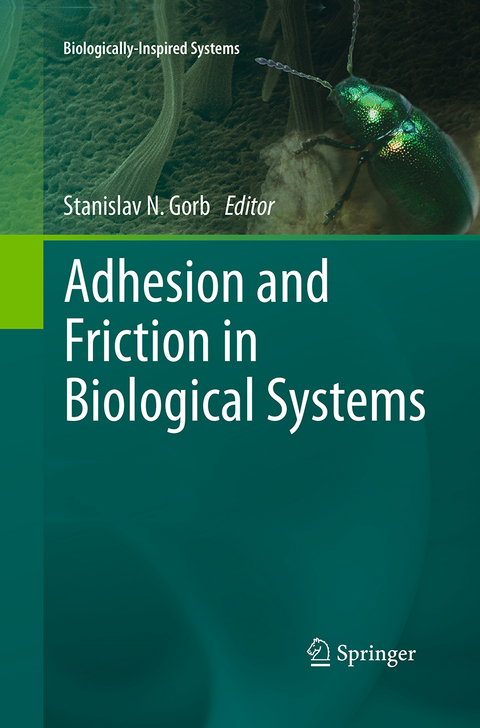
Adhesion and Friction in Biological Systems
Springer (Verlag)
978-94-017-7873-2 (ISBN)
Adhesion and Friction in Biological Systems.- Introduction.- I. Adhesion.- Chapter 1. Pollen grains adhere to the moist mouthparts in the flower visiting beetles.- Chapter 2. Material structure, stiffness, and adhesion: why attachment pads of the grasshopper (Tettigonia viridissima) adhere more strongly than those of the locust (Locusta migratoria) (Insecta: Orthoptera).- Chapter 3. Attachment force of the beetle Cryptolaemus montrouzieri (Coleoptera, Coccinellidae) on leaflet surfaces of mutants of the pea Pisum sativum (Fabaceae) with regular and reduced wax coverage.- Chapter 4. Visualization of epicuticular grease on the covering wings on the Colorado Potato Beetle: A scanning probe approach.- Chapter 5. Fracture behaviour of plant epicuticular wax crystals and its role in preventing insect attachment: a theoretical approach.- II. Friction.- Chapter 6. Microtribology of biological materials.- Chapter 7. Friction and adhesion in the tarsal and metatarsal scopulae of spiders.- Chapter 8. Frictional properties of contacting surfaces in the hemelytra-hindwing locking mechanism in the bug Coreus marginatus (Heteroptera, Coreidae).- Chapter 9. Surface structure and frictional properties of the skin of the Amazon tree boa Corallus hortulanus (Squamata, Boidae).- Chapter 10. Material properties of the skin of the Kenyan sand boa Gongylophis colubrinus (Squamata, Boidae).- III. Attachment Devices.- Chapter 11. Evolution of locomotory attachment pads of hexapods.- Chapter 12. Ultrastructural architecture and mechanical properties of attachment pads in Tettigonia viridissima (Orthoptera Tettigoniidae).- Chapter 13. Contact behaviour of tenent setae in attachment pads of the blowfly Calliphora vicina (Diptera, Calliphoridae).- Chapter 14. The probable purpose of the mid-coxal prong in Brachycera (Diptera).- IV. Attachment-related behaviour.- Chapter 15. Contact mechanics at the insect-plant interface: How do insects stick and how do plants prevent this?.-Chapter 16. Insect walking techniques on thin stems.- Chapter 17.- Plant surface-bug interactions: Dicyphus errans stalking along trichomes.- Chapter 18. Locomotion in a sticky terrain.- Index.- Literature.
| Erscheinungsdatum | 18.06.2016 |
|---|---|
| Reihe/Serie | Biologically-Inspired System ; 3 |
| Zusatzinfo | XIII, 280 p. |
| Verlagsort | Dordrecht |
| Sprache | englisch |
| Maße | 155 x 235 mm |
| Themenwelt | Naturwissenschaften ► Biologie ► Botanik |
| Naturwissenschaften ► Biologie ► Zoologie | |
| Naturwissenschaften ► Physik / Astronomie ► Angewandte Physik | |
| Technik ► Maschinenbau | |
| ISBN-10 | 94-017-7873-6 / 9401778736 |
| ISBN-13 | 978-94-017-7873-2 / 9789401778732 |
| Zustand | Neuware |
| Haben Sie eine Frage zum Produkt? |
aus dem Bereich


